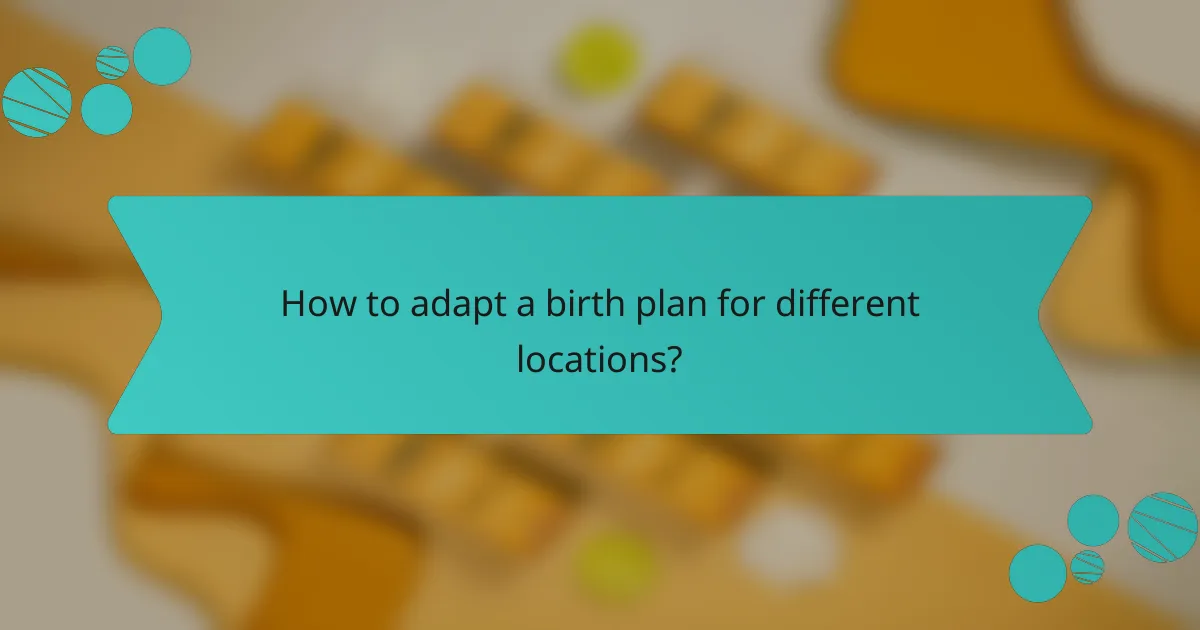A birth plan is an essential document that details a pregnant person’s preferences for labor and delivery, helping healthcare providers understand their wishes. By creating a birth plan, expectant parents can effectively communicate their priorities and facilitate important discussions with their healthcare team. Utilizing available templates can streamline this process, ensuring that all preferences are clearly outlined and addressed.

What is a birth plan?
A birth plan is a document that outlines a pregnant person’s preferences for labor and delivery. It serves as a guide for healthcare providers to understand the individual’s wishes regarding the birthing process.
Definition of a birth plan
A birth plan is essentially a written outline that details a person’s choices and preferences for their childbirth experience. This may include preferences for pain management, labor positions, and who will be present during delivery. It can also address post-birth care for both the parent and the newborn.
While a birth plan is not legally binding, it is an important communication tool between the birthing person and their healthcare team. It helps ensure that the individual’s desires are considered during the labor and delivery process.
Purpose of a birth plan
The primary purpose of a birth plan is to facilitate clear communication about the birthing person’s preferences. This can help reduce anxiety and create a more positive birth experience by ensuring that the healthcare team is aware of the individual’s wishes.
Additionally, a birth plan can serve as a reference point for discussions with healthcare providers. It encourages conversations about options, potential interventions, and any concerns the birthing person may have, allowing for informed decision-making.
To create an effective birth plan, consider including sections on pain relief options, desired labor environment, and preferences for newborn care. It’s also beneficial to remain flexible, as circumstances during labor may necessitate adjustments to the original plan.

How to create a birth plan?
Creating a birth plan involves outlining your preferences for labor and delivery, ensuring that your wishes are communicated to your healthcare team. This document can help guide discussions with your provider and clarify your priorities during the birthing process.
Step-by-step guide
Start by gathering information about the birthing process, including different options for pain management, delivery positions, and potential interventions. Researching these topics will help you make informed decisions that align with your values and preferences.
Next, draft your birth plan by listing your preferences in a clear, concise manner. Consider using bullet points for easy readability. Share this draft with your healthcare provider during your prenatal visits to discuss any concerns or adjustments needed.
Finally, be flexible. Birth can be unpredictable, so while it’s important to have a plan, be open to changes based on your circumstances and medical advice during labor.
Essential components to include
Your birth plan should include key elements such as your preferred labor environment, support persons, and pain relief options. Specify whether you want a natural birth, the use of epidurals, or other pain management techniques.
Additionally, outline your preferences for the delivery process, including positions you wish to try and any specific requests for immediate postpartum care, such as skin-to-skin contact or delayed cord clamping. It’s also helpful to include your wishes regarding newborn procedures, like vaccinations or feeding methods.
Lastly, consider adding a section for any contingencies, such as preferences in case of a cesarean section or other medical interventions. This ensures that your wishes are respected as much as possible, even if circumstances change.

What templates are available for birth plans?
Various templates for birth plans are available to help expectant parents outline their preferences for labor and delivery. These templates can guide discussions with healthcare providers and ensure that important wishes are communicated effectively.
Popular birth plan templates
Common birth plan templates include the “Simple Birth Plan,” which focuses on essential preferences like pain management and support people, and the “Detailed Birth Plan,” which covers a broader range of topics such as labor environment, medical interventions, and postpartum care. Many hospitals also provide their own templates that align with their policies and procedures.
Online resources, such as websites from childbirth organizations, often offer customizable templates that can be downloaded and printed. These templates may include checklists and prompts to help parents think through their options.
How to customize templates
Customizing a birth plan template involves reflecting personal preferences and specific circumstances. Start by reviewing each section of the template and considering what is most important for your birth experience, such as preferred pain relief methods, who will be present, and any cultural or religious practices you want to incorporate.
When customizing, be clear and concise. Use bullet points for easy readability and prioritize your preferences. Avoid overwhelming your healthcare team with excessive detail; instead, focus on the key points that matter most to you. Regularly discuss and update your plan with your healthcare provider to ensure alignment with their practices and any hospital policies.

What preferences should be documented in a birth plan?
Documenting preferences in a birth plan helps ensure that your wishes are respected during labor and delivery. Key areas to address include labor preferences, delivery preferences, and postpartum care preferences, allowing you to communicate your choices clearly to your healthcare team.
Labor preferences
Labor preferences encompass your choices regarding pain management, mobility, and support during labor. Consider whether you want to use natural methods like breathing techniques or if you prefer medication such as epidurals or nitrous oxide.
Additionally, think about your desired environment. Would you like dim lighting, music, or specific people present? Discuss these preferences with your healthcare provider to ensure they can be accommodated.
Delivery preferences
Delivery preferences focus on how you want to give birth, including positions, interventions, and who will be present. You may want to specify if you prefer to deliver in a specific position, such as squatting or on your side, rather than lying flat on your back.
Consider whether you want immediate skin-to-skin contact with your baby after birth or delayed cord clamping. It’s essential to communicate these preferences to your medical team to align their practices with your wishes.
Postpartum care preferences
Postpartum care preferences involve your choices for recovery and newborn care after delivery. You may want to outline your wishes for breastfeeding, formula feeding, or both, and whether you prefer to have your baby room-in with you or stay in the nursery.
Additionally, consider your preferences for pain management and support during recovery. Discussing these aspects with your healthcare provider can help ensure a smoother transition into parenthood.

What discussion points should be covered with healthcare providers?
When creating a birth plan, it’s essential to cover key discussion points with healthcare providers to ensure that your preferences and concerns are understood. This involves asking specific questions and addressing important topics that can impact your birthing experience.
Key questions to ask
Start by asking about the hospital’s policies regarding labor and delivery. Questions like, “What is your approach to pain management?” or “How do you handle unexpected complications?” can provide clarity on the care you can expect. It’s also beneficial to inquire about the availability of support persons during labor and delivery.
Consider asking about the use of interventions such as continuous fetal monitoring or IV fluids. Understanding the circumstances under which these interventions are used can help you make informed decisions about your birth plan.
Important topics to address
Discuss your preferences for pain relief options, ranging from natural methods to medical interventions like epidurals. Knowing what options are available and the potential risks and benefits of each can guide your choices during labor.
Another critical topic is the immediate care of your newborn. Address whether you prefer skin-to-skin contact right after birth, delayed cord clamping, or specific feeding plans. These preferences can significantly affect your early bonding experience.
Lastly, talk about postpartum care and support. Discuss what resources are available for breastfeeding support, mental health, and recovery, as this can help you prepare for the transition to parenthood.

How to involve your partner in the birth plan?
Involving your partner in the birth plan is essential for creating a supportive environment during labor. This collaboration ensures that both partners are aligned on preferences and can effectively advocate for each other’s needs.
Role of the partner
The partner’s role in the birth plan can vary but generally includes providing emotional support, assisting with comfort measures, and communicating preferences to the medical team. They should be familiar with the birth plan to help ensure that the birthing experience aligns with the couple’s wishes.
Partners can also take on practical tasks, such as packing the hospital bag or arranging transportation. Being proactive in these areas can reduce stress and allow the birthing person to focus on labor.
Communication strategies
Effective communication is key to involving your partner in the birth plan. Schedule dedicated time to discuss your preferences, concerns, and expectations, ensuring both partners feel heard and understood. Use open-ended questions to facilitate deeper conversations.
Consider creating a written document that outlines preferences and roles, which can be shared with healthcare providers. This can serve as a reference point during labor, helping to minimize misunderstandings and ensure that everyone is on the same page.

What are common misconceptions about birth plans?
Many people believe that birth plans are rigid documents that dictate every aspect of labor and delivery. In reality, they are flexible tools designed to communicate preferences and facilitate discussions between expectant parents and healthcare providers.
Misunderstandings about flexibility
A common misconception is that a birth plan must be strictly followed, leaving no room for adjustments during labor. However, circumstances can change, and flexibility is crucial. It’s essential to approach your birth plan as a guide rather than a contract, allowing for adaptations based on medical advice or unexpected developments.
For instance, if a laboring person initially prefers a natural birth but encounters complications, being open to interventions like pain relief or a cesarean section can ensure the safety of both mother and baby. Discussing these potential scenarios with your healthcare team can help set realistic expectations.
Myths regarding hospital policies
Some believe that hospitals will not honor any preferences outlined in a birth plan. In truth, many hospitals encourage the use of birth plans to better understand patient desires. However, it’s important to recognize that hospital policies and protocols may influence the extent to which preferences can be accommodated.
For example, while a birth plan may express a desire for delayed cord clamping, the hospital may have specific guidelines that dictate when this can occur based on the baby’s condition. Engaging in open dialogue with your healthcare provider about what is feasible within the hospital’s framework can help clarify what can be included in your birth plan.

How to adapt a birth plan for different locations?
Adapting a birth plan for different locations involves understanding the specific policies, resources, and support systems available at each site. Whether planning for a hospital, birthing center, or home birth, it’s crucial to tailor your preferences to align with the environment and care providers.
Home birth considerations
When planning a home birth, consider the availability of trained midwives and emergency medical services. Ensure that your chosen midwife is licensed and familiar with local regulations regarding home births, as these can vary significantly by region.
It’s essential to prepare your home environment for the birth. Designate a clean, comfortable space with necessary supplies, such as birthing pools, towels, and medical kits. Discuss your preferences for pain management, monitoring, and any interventions with your midwife in advance.
Additionally, consider creating a backup plan in case of complications. This may include having a nearby hospital identified and ensuring that your midwife has a clear protocol for transferring care if needed. Communicate openly with your support team about your wishes and any concerns you may have.
